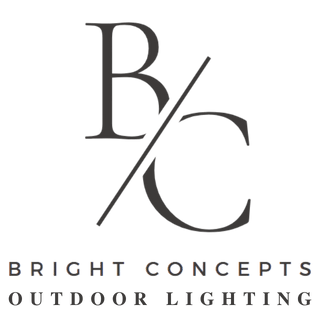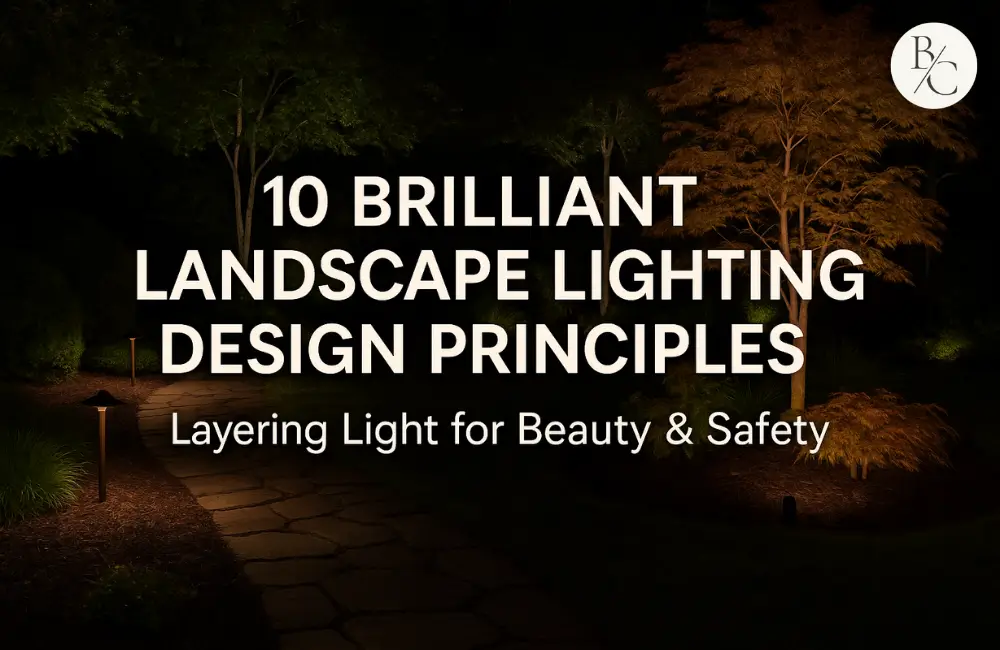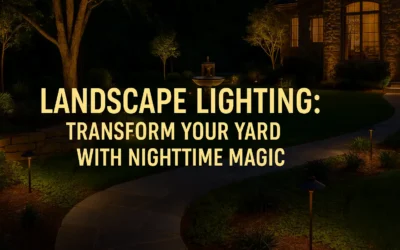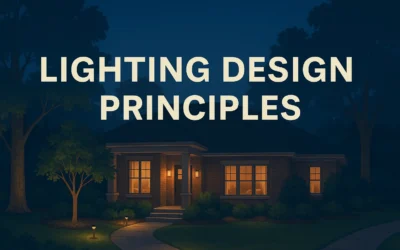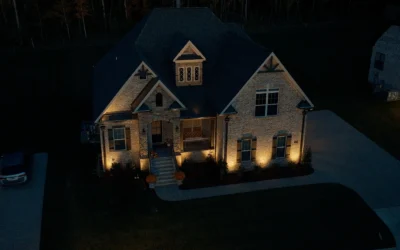1. Imagine the Night: Why Good Lighting Feels Like Magic
Ever stepped onto a moonlit patio where every leaf shimmers and shadows dance? Or fumbled up an unlit stair, heart thumping, wishing for one reliable beam? Landscape Lighting Design Principles: Layering Light for Beauty & Safety answer both moments—mixing artistry with, um, rock-solid safety. Picture jasmine scents drifting through soft pools of warm light… Your yard’s nighttime story starts here, and you’re the director holding the dimmer.
2. Core Concept—Three Layers, One Cohesive Glow
Layering outdoor light is like composing a movie soundtrack: ambient sets the mood, task guides action, accent hits the high notes. Miss one, and, well… the scene falls flat.
Ambient Light (the canvas)
A broad 2700 K wash—think tree-mounted moonlights—creates a gentle, see-everything backdrop. Aim for 1–3 fc so eyes adjust without glare.
Task Light (the guide)
Path lights, recessed tread LEDs, and bollards pump 5–8 fc exactly where ankles twist and keys drop. Here’s the kicker… bright doesn’t mean blinding; shield beams below eye level.
Accent Light (the drama)
Tight 15° spots on a Japanese maple or a water wall pull focus. But wait… don’t highlight every object; contrast makes stars sparkle.
3. Informational Intent: Key Design Factors Every DIYer Must Know
Choosing optics feels technical, yet it’s surprisingly tactile—stand outside at dusk, listen to crickets, and watch how a 25° beam sculpts bark textures.
- Beam Angles & Distribution
- 10° pencil beams = flagpoles, statues
- 38° mediums = shrubs, smaller trees
- 60° floods = façades, hedges
- Color Temperature & CRI
- 2200 K: intimate fire-pit vibe
- 3000 K: balanced “living room” tone
- 90 + CRI LEDs keep rose petals crimson, not muddy brown
4. Transactional Intent: Choosing Fixtures & Accessories That Last
Shopping time! You’ll want housings that shrug off monsoon rains and coastal salt spray.
- Die-cast brass spotlights—lifetime warranty, patina gracefully.
- Composite well lights—budget-friendly, withstand lawnmowers.
- Stainless-steel transformers—multi-tap outputs tame voltage drop.
- Smart Wi-Fi hubs—voice control via Alexa or Google.
Real-world price check: swapping twenty 20 W halogens for 4 W LEDs? Payback lands at roughly 11 months on a $0.15/kWh utility rate.
5. Long-Tail Intent: Low-Voltage Garden Lighting for Small Urban Yards
Tiny space, towering impact. Mount a single 7 W uplight in a dwarf olive, tuck 1-W micro-step LEDs into brick risers, and bounce a hidden strip along a cedar fence. Voilà—cozy courtyard theatre. Average power draw: under 30 W, or less than a laptop charger.
6. Broad Intent: Full-Property Lighting Master Plan
Think zones: driveway, entry, dining patio, play lawn, back fence. Separate circuits mean dinner guests bask in candle-warm light while the kids’ soccer goal stays softly lit at 3000 K. Program scenes—“Entertain,” “Security,” “Midnight Snack”—on your phone; you’ll wonder how you lived without them.
7. Sustainability & Dark-Sky Compliance
Shield uplights, aim only where light is needed, and keep CCT below 3000 K to protect fireflies. DarkSky International confirms fixtures labeled “Fixture Seal of Approval” cut skyglow by up to 90 percent.
8. Safety First—Codes, Clearances, and Glare Control
NEC Article 411 caps low-voltage landscape systems at 30 V. Bury UF cable at 6 in minimum, splice with gel-filled connectors, and GFCI-protect the transformer. Add hex louvers on spots near walkways; guests will thank you—no squinting selfies.
9. DIY vs. Pro Installation: Cost, Time, Peace-of-Mind
A 10-fixture DIY kit runs USD 700 and a weekend of trenching. Professional design-build averages USD 4,000 but includes photometrics, warranty, and zero sore backs. Which matters more—budget or Saturday sunrise tee time? Only you know.
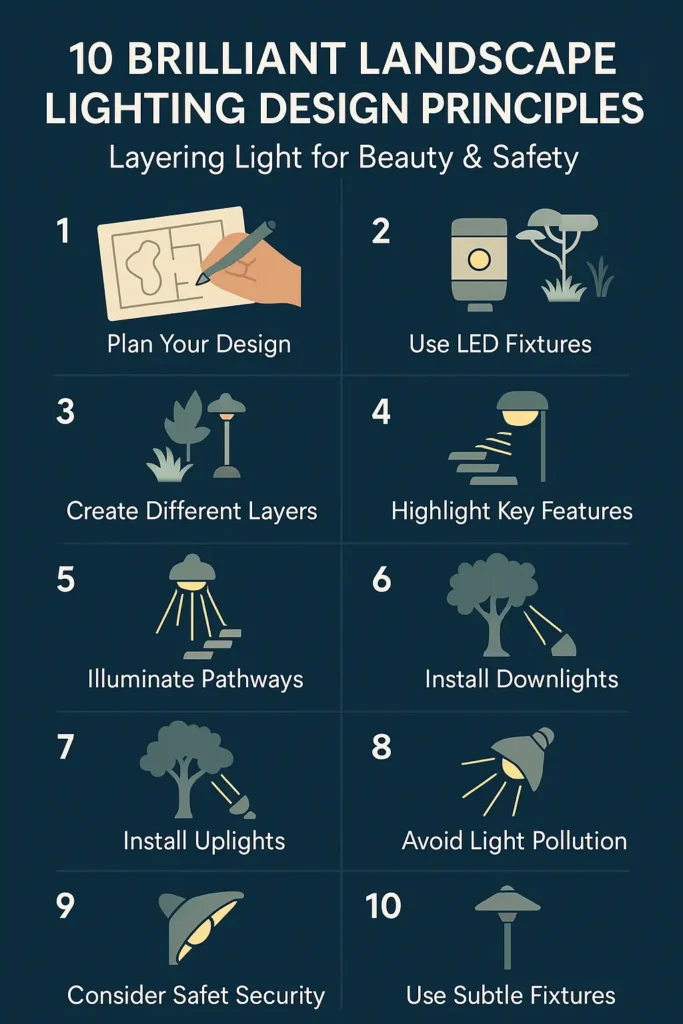
10. Inspiring Real-World Case Studies
- Coastal Cottage, Cornwall: Salt-tough marine-grade sconces warm sandstone walls; moonlighting in a windswept oak guides late-night beach walks.
- Mountain-Modern Retreat, Aspen: 2200 K brass uplights graze lodge-pole pines, while cool-white task LEDs outline an ice-slick driveway. Guests describe it as “ski chalet meets starlight.”
- Urban Zen Courtyard, Singapore: Hidden strip LEDs ripple across bamboo, reflected in koi-pond mirrors. Energy use: a whisper-quiet 18 kWh / month.
Frequently Asked Questions
Q1: How bright should pathway lights be?
A: Target 5–8 foot-candles at ground level—bright enough to spot pebbles, dim enough for star-gazing.
Q2: Can LED color change via app?
A: Yes; RGB-W fixtures let you tweak holidays to pink on Valentine’s Day, golden on Diwali, or… off when turtles nest.
Q3: Do I need a licensed electrician?
A: Low-voltage (≤30 V) work is homeowner-friendly in most jurisdictions, but hard-wired 120 V sconces require a licensed pro.
Q4: Are solar lights worth it?
A: In full-sun gardens, premium solar bollards perform well; in shaded yards, hybrid low-voltage + solar panels give steadier results.
Q5: How often should fixtures be cleaned?
A: Wipe lenses twice a year—spring pollen and fall dust can steal 15 percent of lumen output.
Q6: What’s the lifespan of outdoor LEDs?
A: Quality chips promise 50,000 hours—about 17 years at 8 hours-a-night.
Additional Queries Answered
Q: How to design landscape lighting for safety?
Start by walking every path, stair, and change-of-grade at dusk—phone flashlight in hand—to spot lurking trip hazards. Layer low-glare task lights 18–24 inches off grade, aim beams downward, and maintain 5–8 foot-candles on treads. Add motion sensors at entries for “surprise-free” arrivals, and place transformers on GFCI-protected circuits. Finally, use warm 3000 K LEDs so eyes adjust quickly between lit and unlit zones. Peace of mind, delivered.
Q: What are the best LEDs for outdoor landscape lighting?
Look for sealed, IP65-or-higher fixtures housing 90+ CRI, 2700–3000 K chips from reputable makers like Cree or Nichia. Choose integrated LEDs over drop-in lamps for tighter thermal control—40,000+ hour lifespans are the norm. Need tunable color? Pick RGB-W lights with DMX or BLE control. Here’s the kicker… spending a little more on high-quality drivers prevents flicker and voltage-drop headaches down the road.
Q: Guide to layering light in landscape design?
Think three beats: ambient (moon-style tree lights for soft fill), task (step, path, and gate lights for navigation), and accent (narrow beams on focal trees or sculptures). Sketch zones first, assign circuit numbers next, and let dimmers fine-tune brightness so layers blend but never compete. But wait… always test with temporary stakes before trenching; a five-minute mock-up saves hours of rewiring.
Q: Common issues with outdoor lighting implementation?
Voltage drop dims far-end fixtures—combat it with heavier gauge cable or multi-tap transformers. Water intrusion? Use gel-filled connectors and IP-rated housings. Glare bombs blind guests; install hex louvers or half shields. Finally, mismatched color temperatures scream “patchwork.” Stick within a 500 K window—your nightscape will feel intentional, not accidental.
Q: Landscape lighting design vs. regular lighting design?
Indoor “regular” lighting fights enclosure; landscape lighting works with vast darkness. Indoors, ceilings bounce light; outdoors, there’s no ceiling, so contrast matters more than brightness. Exterior fixtures brave rain, UV, and critters, demanding robust IP ratings. And while interior designers fret over reflections, landscape pros worry about skyglow and neighbor sightlines. Two realms, same physics—utterly different priorities.
Q: Why does good landscape lighting feel like magic?
Because it plays with human perception. Warm pools of light trigger cozy, campfire instincts; shadow pockets spark intrigue. Proper accent beams reveal textures your daytime eyes missed—ruffled bark, rippling water. The brain stitches these contrasts into a cinematic scene, and suddenly the mundane backyard becomes, well, enchanting. That gut “wow” response? Pure neuroscience wrapped in photons.
Q: Step-by-step guide to creating ambient outdoor spaces with light?
- Inventory trees, walls, and gathering spots.
- Choose 2700–3000 K wash lights to mimic twilight.
- Mount fixtures high—eaves or 25 ft branches—for soft downward spill.
- Overlap beams to erase hot spots; dim to 1–3 foot-candles.
- Add photocell + timer for automatic dusk-to-midnight cycles.
- Test, tweak, enjoy. Ambient mood achieved in six easy moves!
Q: Tips for creating jaw-dropping outdoor rooms with light?
Mix texture and contrast like a painter. Graze a stone wall so every ridge pops; hide strip LEDs under seat walls for floating edges; crown one dramatic tree with a tight uplight—instant focal point. Vary color temps subtly (warm seating, neutral foliage) and use smart scenes: “Dinner,” “Afterglow,” “Stargaze.” Guests will wander out, sigh, and say, “I never want to leave…”
Conclusion & Call-to-Action
Landscape Lighting Design Principles: Layering Light for Beauty & Safety aren’t just theory—they’re the fast track to evenings filled with laughter, shadow-play, and a reassuring sense that, hey, you’ve got every step covered. Ready to sketch your own nightscape? Download our free one-page zone planner, grab a flashlight for mock-ups tonight, and see how a subtle beam transforms everything you thought you knew about your yard.

